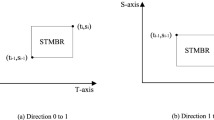Abstract
Movement is a complex process that evolves through both space and time. Movement data generated by moving objects is a kind of big data, which has been a focus of research in science, technology, economics, and social studies. Movement database is also at the forefront of geographic information science research. Developing efficient access methods for movement data stored in movement databases is of critical importance. Tree-like indexing structures such as the R-tree, Quadtree, Octree are not suitable for indexing multi-dimensional movement data because they all have high space cost of their inner nodes. In addition, it is difficult to use them for parallel access to multi-dimensional movement data because they thereof, are in hierarchical structures, which have severe overlapping problems in high dimensional space. In this paper, we propose a novel access method, the Decomposition Tree (D-tree), for indexing multi-dimensional movement data. The D-tree is a virtual tree without inner nodes, instead, through an encoding method based on integer bit-shifting operation, and can efficiently answer a wide range of queries. Experimental results show that the space cost and query performance of D-tree are superior to its best known competitors.






Similar content being viewed by others
References
Guo, H., et al.: Scientific big data and digital Earth. Chin. Sci. Bull. 59(35), 5066–5073 (2014)
Long, J.A., Nelson, T.A.: A review of quantitative methods for movement data. Int. J. Geogr. Inf. Sci. 45, 1–27 (2012)
Wang, L., et al.: Cloud computing: a perspective study. New Gener. Comput. 28(2), 137–146 (2010)
Wang, L., et al.: Towards enabling cyberinfrastructure as a service in clouds. Comput. Electr. Eng. 39(1), 3–14 (2013)
Chen, D., et al.: Fast and scalable multi-way analysis of massive neural data. IEEE Trans. Comput. 64(3), 707–719 (2015)
Wang, L., et al.: Particle swarm optimization based dictionary learning for remote sensing big data. Knowl. Based Syst. 79, 43–50 (2015)
Saltenis, S., et al.: Indexing the positions of continuously moving objects. SIGMOD Rec. 29(2), 331–342 (2000)
Lin, B., Su, J.W.: On bulk loading TPR-tree. In: 2004 IEEE International Conference on Mobile Data Management. pp. 114–124 (2004)
Tao, Y., et al., The TPR*-Tree: An Optimized Spatio-Temporal Access Method for Predictive Queries. In: Proceedings 2003 VLDB Conference, pp. 790–801. Morgan Kaufmann, San Francisco (2003)
Kim, S.W., Jang, M.H., Lim, S.: Active adjustment: an effective method for keeping the TPR*-tree compact. J. Inf. Sci. Eng. 26(5), 1583–1600 (2010)
Christian, S.J., Dan, L., Beng Chin, O.: Query and update efficient B\(^{+}\)-tree based indexing of moving objects. In: Proceedings of the Thirtieth International Conference on Very Large Data Bases, vol. 30. VLDB Endowment, Toronto (2004)
Xiaopeng, X., Mohamed, F.M., Walid, G.A.: LUGrid: update-tolerant grid-based indexing for moving objects. In: Proceedings of the 7th International Conference on Mobile Data Management. IEEE Computer Society (2006)
Mindaugas, P., et al.: Indexing the past, present, and anticipated future positions of moving objects. ACM Trans. Database Syst. 31(1), 255–298 (2006)
Yiu, M.L., Tao, Y.F., Mamoulis, N.: The B-dual-tree: indexing moving objects by space filling curves in the dual space. VLDB J. 17(3), 379–400 (2008)
Chen, N., et al.: Adaptive indexing of moving objects with highly variable update frequencies. J. Comput. Sci. Technol. 23(6), 998–1014 (2008)
Jensen, C., et al.: Indexing the Trajectories of Moving Objects in Symbolic Indoor Space Advances in Spatial and Temporal Databases, pp. 208–227. Springer, Berlin (2009)
Chen, N., et al.: B(S)-tree: a self-tuning index of moving objects, part II. In: Proceedings of Database Systems for Advanced Applications, pp. 1–16 (2010)
Lin, H.Y., Indexing the trajectories of moving objects. In: Imecs 2009: International Multi-Conference of Engineers and Computer Scientists, vol. I, II, pp. 732–737. International Association Engineers-IAENG, Hong Kong (2009)
Lin, H.Y.: Using compressed index structures for processing moving objects in large spatio-temporal databases. J. Syst. Softw. 85(1), 167–177 (2012)
Bayer, R., McCreight, E.M.: Organization and maintenance of large ordered indexes. Acta Inf. 1(3), 173–189 (1972)
Guttman, A.: R-trees: a dynamic index structure for spatial searching. SIGMOD Rec. 14(2), 47–57 (1984)
Nguyen-Dinh, L.-V., Aref, W.G., Mokbel, M.F.: Spatio-temporal access methods: part 2 (2003–2010). Bulletin of the IEEE Computer Society Technical Committee on Data Engineering (2010)
Norbert, B., et al.: The R*-tree: an efficient and robust access method for points and rectangles. SIGMOD Rec. 19(2), 322–331 (1990)
Tao, Y., Papadias, D., Sun, J.: The TPR*-tree: an optimized spatio-temporal access method for predictive queries (2003)
Lin, H.-Y.: Using B+-trees for processing of line segments in large spatial databases. J. Intell. Inf. Syst. 31(1), 35–52 (2008)
Huang, M.L., Hu, P., Xia, L.F.: A grid based trajectory indexing method for moving objects on fixed network. In: 2010 18th International Conference on Geoinformatics (2010)
Chen, H., et al.: Recent Trends in Wireless and Mobile Networks. A cyclic-translation-based grid-quadtree index for continuous range queries over moving objects, pp. 95–109. Springer, Berlin (2011)
Nievergelt, J., Hans, H., Kenneth, C.S.: The grid file: an adaptable, symmetric multikey file structure. ACM Trans. Database Syst. 9(1), 38–71 (1984)
Acknowledgments
The work described in this paper was supported by National Natural Science Foundation of China (41101368, 41172300) and National High Technology Research and Development Program of China (2012AA121401).
Author information
Authors and Affiliations
Corresponding author
Rights and permissions
About this article
Cite this article
He, Z., Wu, C., Liu, G. et al. Decomposition tree: a spatio-temporal indexing method for movement big data. Cluster Comput 18, 1481–1492 (2015). https://doi.org/10.1007/s10586-015-0475-3
Received:
Revised:
Accepted:
Published:
Issue Date:
DOI: https://doi.org/10.1007/s10586-015-0475-3




